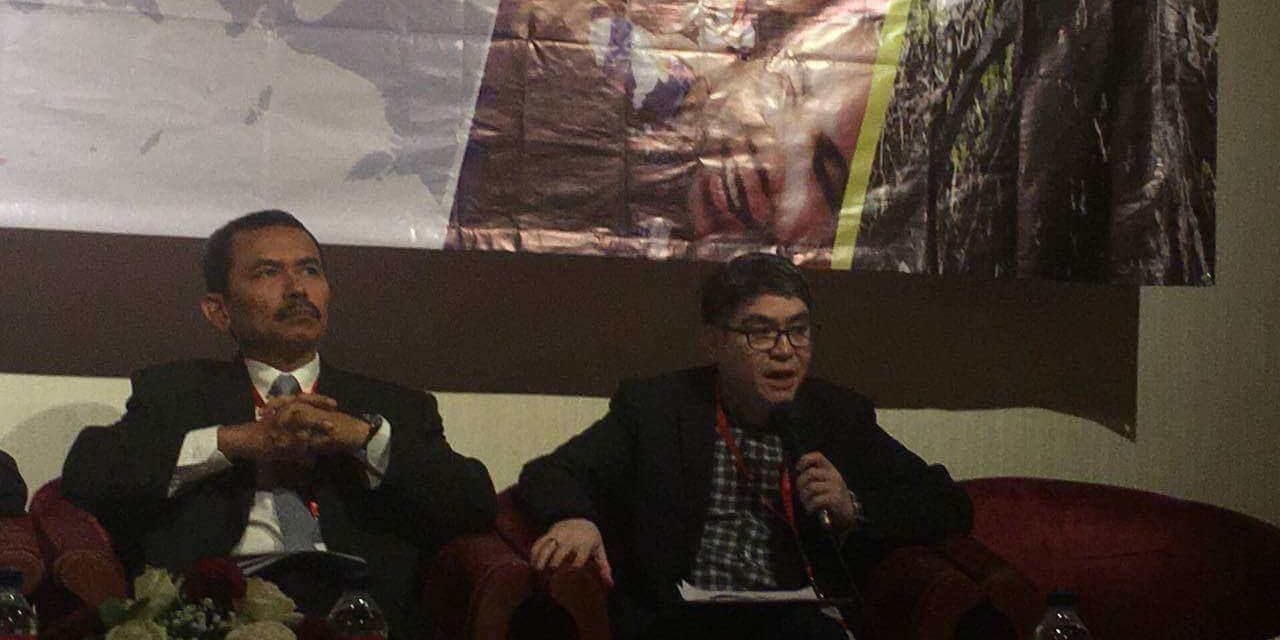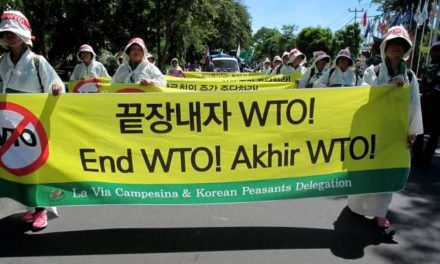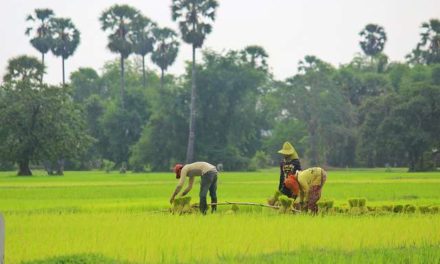Presentation at the Dialogue on RCEP Negotiations and their impact on Human Rights and the Environment: The Role of Parliamentarians and Other Stakeholders
By Joseph Purugganan, Focus on the Global South
Good morning. It is a privilege to be given this space and opportunity to share our perspective on the on-going talks towards a Regional Comprehensive Economic Partnership Agreement or RCEP. On behalf of my organization Focus on the Global South, I extend our sincere gratitude to the ASEAN Parliamentarians for Human Rights for inviting us in this important conversation.
I have four main points I want to underscore today:
1. First point is the need to situate RCEP talks in a larger context. And I would like to highlight at the onset the peoples resistance not just to trade agreements like RCEP but against the broader policies that have driven what many have referred to as corporate globalization. Here I would like to discuss a broader, more general context of resistance, and a more RCEP-specific context.
The broader context is the backlash against globalization that we have seen across many parts of the globe. This phenomenon has been observed in the Brexit vote in the UK, the election of Rodrigo Duterte in the Philippines, and the most recent ascension to power of Donald Trump in the United States.
The phenomenon of people- mostly working class people- expressing dissatisfaction over the impacts of globalization (i.e. loss of jobs and livelihoods, poor public services like education, health, and public transport, ever increasing inequality and wealth concentration), and using the power of the vote, to express that anger against politicians who espouse, support or perceive to be supporting these anti-people policies. While there may be nuances, and the case is clearer in some cases compared to others, for example in the case of Duterte in the Philippines, the ire of the electorate was not bent against globalization policies although there were some discussion over the lack of inclusive growth during the campaign- the ire of the electorate was against the politicians or the elites as represented by the Philippine oligarchy, rather than on the policies. A common feature nevertheless of the globalization backlash is that unfortunately, right wing politicians, are the ones who have effectively tapped into the public outcry and thus been able to maximize the backlash to their political advantage.
What is lost however in the noise, is the fact that the subject of the outcry should not be globalization per se, but against corporate globalization. The kind of globalization that advances and is driven by the corporate agenda rather than peoples needs. RCEP and all the other mega FTAs, is a key component of the agenda of corporate globalization.
Which leads me to the growing peoples resistance against RCEP. While there is as yet no public outcry against RCEP, for how can people in general resist something that they know very little about, or the fact that trade policies one or two steps remove from the bread and butter issues, the resistance to RCEP is nonetheless to my view growing and intensifying. We’ve seen a series of peoples actions against RCEP that started in Jakarta in 2016, then to Kobe, Manila, and most recently Hyderabad in India, where the overwhelming demand of various peoples organizations, NGOs, CSOs, academics, HR networks is for governments and the people to REJECT RCEP.
The main concerns revolve around loss of jobs, the need for secure jobs, the threats to livelihoods of farmers and fishers, and the related threat to food sovereignty, the negative impacts on farmers right to seeds, and the small fishers access to marine resources, the threats to public services like education and health, the threat to access to affordable life-saving medicines, the impact of investments on land and indigenous territory; the threats to the environment, and the impact on human rights.
Concerns were also raised on broader issues like investments and the threats to public policies and regulations from the investor-state-dispute-settlement provisions in RCEP.
Another fundamental concern raised was the lack of transparency and the democratic deficit hounding the negotiations themselves.
It is clear that the people have taken a stand against RCEP even if their governments are more aggressively pushing in the other direction. The debates on RCEP and trade policies in the halls of Congress and Parliaments across SEA should take these issues into account.
2. The second point I want to underscore is how the ambitious agenda underpinning these agreements is also creating problems for the negotiations.
RCEP, TPP, TTIP, CETA these are all mega FTAs, or so called new generation FTAs that are key elements of what is called the 21st Century trade and investment regime.
Over the past couple of years however, negotiations for these big trade deals have been faltering, prompting one analyst to declare that “the era of the big trade deal is certainly in hibernation. The question now is whether it is dead altogether.”[i]
The difficulties in seeing these negotiations through can be attributed to a combination of factors. There is the complexity of the trade deals themselves— covering so many chapters, and dealing with varying sets of rules, across several countries and continents. The negotiations for these mega FTAs have also been affected by changing tides in domestic politics, with the election of Trump in the US causing the greatest disruption.
With TPP moribund under Trump, RCEP has emerged as the biggest game in town. While generally seen as a less ambitious agreement compared to the TPP when the negotiations started, what we are seeing is that there is a stronger push in the wake of the TPP debacle, to bring higher standards to make RCEP agenda increasingly more and more like TPP.
One issue that has to be tackled squarely by RCEP is the issue of development asymmetry.
The economies of the 16-country RCEP account for around $22.8 trillion, or roughly around 30% of the global economy.[ii] The aggregate figure however, belies the asymmetry that exists within RCEP.
In terms of Gross National Income (GNI), China with its $10.83 trillion economy is easily the biggest in RCEP. A distant second is Japan with $4.9 trillion, followed by India with $2.08 trillion. In comparison, the economies of the three least developed countries in ASEAN- Myanmar (0.57 %) Cambodia (0.15 %) and Lao PDR (0.10 %) – account for less than half of one percent of China’s huge economy.[iii]
In terms of per capita GNI, Australia tops all RCEP countries with per capita income of $60,050. This is closely followed by Singapore ($52,090), New Zealand ($40,020), Japan ($38,840), and Brunei ($38,010). Based on GNI figures from the World Bank, seven countries in RCEP (Cambodia, Laos, Myanmar, Vietnam, Philippines, Indonesia, and India) are classified as low-middle income countries, while three countries (China, Malaysia, and Thailand) fall within the upper-middle income classification. Australia, New Zealand, Singapore, Brunei, Japan, and Korea on the other hand are classified as high income economies.
This development asymmetry poses the biggest challenge for governments in RCEP. How parties can forge an agreement that is ambitious enough to satisfy the needs of the high and middle-income economies while also recognizing the development agenda of the poorer and smaller economies.
This issue of development asymmetry is a crucial one for ASEAN governments. ASEAN leaders have time and again asserted the centrality of ASEAN in the RCEP talks, looking at RCEP essentially as a further consolidation of its existing trade agreements with its dialogue partners.
ASEAN engagement on RCEP is guided by Guiding Principles and Objectives for Negotiating the RCEP towards the swift conclusion of the RCEP negotiations.”[iv]
Aside from asserting ASEAN centrality in the talks, the guiding principles and objectives of ASEAN in negotiating RCEP also include a principle that could very well temper the push of Japan, Korea and others to increase the ambition of RCEP.
ASEAN governments stated that being cognizant of “the different levels of development of the participating countries, the RCEP will include appropriate forms of flexibility including provision for special and differential treatment, plus additional flexibility to the least-developed ASEAN Member States, consistent with the existing ASEAN+1 FTAs, as applicable.”[v]
The Philippines, as Chair of ASEAN for 2017, will play a key role in the RCEP talks. After the 18th round of negotiations, the talks will move to Hyderabad, India, for the 19th round in July, before moving back to the Philippines in September for a Ministerial Meeting, and then to South Korea in October for the 20th round of talks, where parties are hoping to finally conclude the negotiations.
How the various groupings in the talks are able to muster and consolidate support for their positions will determine whether the RCEP talks will produce a TPP-like highly ambitious agreement, or a more moderate agreement that takes into consideration the asymmetries that exists among the parties.
Aside from development asymmetry, and the varying positions of government, the RCEP talks are also weighed-down by the negotiating agenda itself.
RCEP is not a simple free trade agreement where we deal with reduction of tariffs and market access. It is a highly ambitious agreement that goes beyond trade in fact.
It is an agreement that could determine what kind of intellectual property rights regulation will be put in place; which would then have a bearing on the level of IPR protection, and ultimately on questions of access to things such as medicines, life saving drugs, and seeds. Here too we must emphasize the asymmetry.
Among the RCEP countries, Singapore (4th), New Zealand (6th), Japan (14th), and Australia (16th) rank highest in terms of IPR protection. While Thailand (121st), Cambodia (130th) and Myanmar* (134th) are at the tail end of the global rankings.
Stronger/stricter IPR protection have already been criticized by many groups including the UNDP and UNAIDS for their potential negative impact on public health and access to medicines.
The IPR chapter is also seen as undermining farmers’ rights. The IPR chapter in RCEP will force countries to comply with UPOV 91[vi], an international convention that has been highly criticized by farmers organizations and support groups for “eliminating the right of farmers to save privatized seeds and also limited what other plant breeders can do with that seed.”[vii] Focus on the Global South analyst, Afsar Jafri, sees this as part of a strong push towards corporate agriculture and agribusiness, and a concerted effort to undermine farmers’ rights.[viii]
Among the 16 RCEP countries, only five countries (Australia, Japan, Republic of Korea, Singapore, and Vietnam) are parties to UPOV 1991. China and New Zealand are members of the UPOV but have not signed on to the 1991 Act of the convention, while the remaining 9 countries (Brunei, Cambodia, India, Indonesia, Laos, Malaysia, Myanmar, the Philippines, and Thailand) are not even members of UPOV.
Countries that are not a party to UPOV and UPOV 1991 however, are being made to ratify or accede to UPOV 1991 and or comply with UPOV 1991 standards. In the case of the Philippines for example, the Department of Agriculture sought from UPOV Council an examination of conformity to UPOV 1991 of the country’s Plant Variety Protection Act of 2002. The Council was then asked to “advise the Government of the Philippines that the Law incorporates the majority of the provisions of the 1991 Act, but still needs some clarifications and amendments, as provided in this document, in order to conform with the 1991 Act; once the above clarifications and amendments are incorporated in the Law, the Government of the Philippines is invited to request the examination of the amended law as provided in Article 34(3) of the 1991 Act.[ix]
The Philippine experience, and those of other countries that are being made to amend their national laws, shows the tremendous influence that international standard setting conventions like UPOV have on domestic policies, with far reaching implications on how a country can pursue development of its agriculture sector and secure the livelihoods of its farmers and food producers.
Perhaps one of the most contentious issues is that if the investor state dispute settlement mechanism, or ISDS. There are people here more able to speak on that so I will not dwell on ISDS too much except to repeat a quote made at our intervention on ISDS at the stakeholder engagement in Manila.
“RCEP through ISDS will give corporations–many of which have annual revenues bigger than the GDPs of most countries in ASEAN, and therefore have more economic power compared to governments in these countries– the right and even more power to sue governments over public policies and regulations in secret, ad-hoc tribunals. These tribunals or more appropriately, corporate courts, have handed down million dollar rulings that have penalized governments over regulatory actions to defend public health, pursue more inclusive development, protect the environment, and public interest in general.”
“RCEP through ISDS will give corporations–many of which have annual revenues bigger than the GDPs of most countries in ASEAN, and therefore have more economic power compared to governments in these countries– the right and even more power to sue governments over public policies and regulations in secret, ad-hoc tribunals. These tribunals or more appropriately, corporate courts, have handed down million dollar rulings that have penalized governments over regulatory actions to defend public health, pursue more inclusive development, protect the environment, and public interest in general.”
3. The third point I want to make is for us to be mindful of the larger picture beyond RCEP, that is to say also that we need to link the RCEP talks to other issues:
There is increasing coherence on the agenda of connectivity. APEC, ASEAN have their own blueprints, and the WTO is supporting the agenda as well of connectivity and inclusiveness. The connectivity agenda encompass physical infrastructure (roads, ports, bridges, energy projects), and institutional connectivity (standards and regulations). I think the big institutions like the WTO are not just mindful but are in fact strategizing on how this seeming global push for connectivity can be maximized and help sustain the neoliberal, corporate agenda.
Connectivity underlines as well the Belt and Road Initiative of China, a highly ambitious development project meant to spur economic development across Asia and beyond anchored on massive infrastructure investments estimated to cost as much as $900 billion. The Belt and Road Initiative is also seen by some analysts as China’s “geopolitical gambit in order to boost China’s regional clout at a time when Donald Trump’s US looks to be stepping back from Asia.”[x]
Governments across the region seem to be taking their cue and have stepped up infrastructure spending, utilizing various public-private partnership schemes and financing arrangements with China in particular.
4. Fourth is to underscore Trade and human rights issues, which have also been in the spotlight in the wake of worsening human rights conditions across much of Asia. This has prompted trade advocates to work more closely with human rights networks in pushing a trade and human rights agenda that includes calls for a comprehensive human rights impact assessment of trade and investment agreements. Civil society concerns have been echoed by Alfred de Zayas, a United Nations Independent Expert, on the promotion of a democratic and equitable international order. De Zayas notes that “It is high time to mainstream human rights into all trade agreements and World Trade Organization (WTO) rules and regulations, so that trade representatives and dispute-settlers know that trade is neither a ‘stand alone’ regime nor an end in itself.
The primacy of HR over trade and other commercial/economic interests must be upheld. Unfortunately, this is easier said than done, institutions like the European Union for example, a strong advocate for HR, has been hesitant to say the least in pushing the HR issues in trade agreements for two reasons I think. First is the clear reason that the EU wants these trade agreements forged because it sees these are crucial to its economic agenda; and two perhaps because it also does not want the agreements themselves to be the subject of HR impact assessment to look into the negative impacts on HR from these highly ambitious agreements.
These are four main points I wanted to share. I end with a plea to our distinguished legislator here to open the space for more transparent and participatory trade policy making process, listen to the pleas and demands of the people on RCEP, investigate and examine the broader economic issues underpinning these negotiations from the purview of the peoples interest, tame the power of corporations through stronger and more effective regulations. Show the increasingly dissatisfied peoples of ASEAN that coming together rather than isolation can work for the interest of people and nature. Thanks.
Photo courtesy of Maris Dela Cruz.-Cardenas
[i] Barker, Tyson (2016). How TTIP Lost Steam. Foreign Affairs. Online: https://www.foreignaffairs.com/articles/united-states/2016-09-28/how-tt, ip-lost-steam
[ii] World Bank data. Online: http://data.worldbank.org/indicator/NY.GDP.MKTP.CD?view=chart accessed May 2017.
[iii] World Bank. New Country classifications by income level. Online: https://blogs.worldbank.org/opendata/new-country-classifications-2016. Accessed May 2017.
[iv] Chairman’s Statements from the 30th ASEAN Summit held 29 April 2017 in Manila. Online: http://asean.org/chairmans-statement-30th-asean-summit/. 30 April 2017.
[v] ASEAN Guiding Principles and Objectives for Negotiating the Regional Comprehensive Economic Partnership. Online: dfat.gov.au/trade/agreements/rcep/documents/guiding-principles- rcep.pdf accessed May 2017.
[vi] UPOV is the French acronym for The International Union for the Protection of New Varieties of Plants. UPOV91 stands for the 1991 Act of the International Convention for the Protection of New Varieties of Plants (UPOV 1991)
[vii] GRAIN (2015) UPOV 91 and other seed laws: A basic primer on how companies intend to control and monopolize seed. Online: https://www.grain.org/article/entries/5314-upov-91-and- other-seed-laws-a-basic-primer-on-how-companies-intend-to-control-and-monopolise-seeds
[viii] Presentation notes at Agroecology Encounter of Via Campesina. June 2017 in Sri Lanka.
[ix] UPOV (2007) Examination of conformity of the Philippine Plant Variety Protection Act of 2002 with the 1991 Act of the UPOV Convention. online: http://www.upov.int/meetings/en/doc_details.jsp?meeting_id=12283&doc_id=75612
[x] Phillips, Tom (2017) The $900bn question: What is the Belt and Road initiative? The Guardian. 12 May 2017. Online: https://www.theguardian.com/world/2017/may/12/the-900bn-question-what- is-the-belt-and-road-initiative










